Tackle Machine (タックルマシン) was a Second Stage obstacle firstly introduced in SASUKE 5 as the first obstacle, relocating Spider Walk, which was modified compared to the previous tournament, to the second obstacle.
Competitors must push a 50 kg (110 lbs) weight down a tunnel to reach the exit. There is only one way to fail this obstacle, which is timing out (which no one even came close to doing). It was replaced by Narrow in the next tournament.
In an interview, Masato Inui, the current producer of SASUKE, mentioned that the obstacle showed great pacing as the first obstacle of the Second Stage, but this obstacle would end up injuring Yamamoto Shingo's shoulder due to ramming towards the weights despite having safety padding placed on the handles, which is the main reason why it was removed after one tournament.
A similarly obstacle was used as part of American Ninja Warrior 14's Power Tower at the end of each semifinal episodes. This version later served as a standalone obstacle during every qualification episodes in Ninja Warrior France 8.
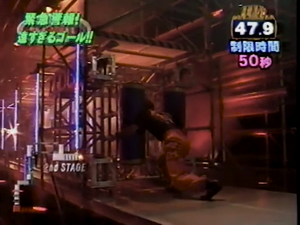
Takeda Toshihiro attempting Tackle Machine
in SASUKE 5
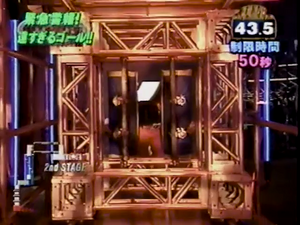
Takeda Toshihiro attempting Tackle Machine
in SASUKE 5, viewed from the goal
Tackle[]
Tackle (タックル) appeared as the fifth obstacle in SASUKE 31's First Stage, replacing first wall from Ni Ren Soritatsu Kabe, which reverted back to the Soritatsu Kabe. Akin to the Tackle Machine, there is only one way for the competitors to fail this obstacle, by timing out. With its appearance, the concept from both obstacles become the first in SASUKE's history to be used in different stages, before being followed by Salmon Ladder due to the introduction of Salmon Ladder Jūgo Dan in SASUKE 35 and Rolling Maruta due to the introduction of Rolling Log in SASUKE 37.
Competitors have to keep pushing three boxes on a 12 meters track until the three boxes are joined altogether. The boxes each weigh 140 kg (roughly 308 lbs.), 160 kg (roughly 352 lbs.), and 180 kg (roughly 396 lbs.) respectively. In total, competitors have to push the weight of 480 kg (roughly 1056 lbs.) to the end. However, from SASUKE 32 onwards, the weight was increased to 240 kg (roughly 528 lbs.), 300 kg (roughly 661 lbs.), and 320 kg (roughly 705 lbs.) respectively, making the total weight increased to 860 kg (roughly 1894 lbs.), almost a ton. Due to the notorious weight, a lot of competitors got fatigue after completing the obstacle and timed out at Soritatsu Kabe.
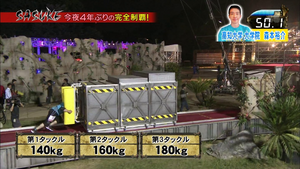
Morimoto Yūsuke attempting Tackle in SASUKE 31
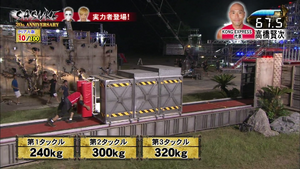
Takahashi Kenji attempting modified Tackle
in SASUKE 34

Murofushi Yuka attempting Tackle in SASUKE 31

Kacy Catanzaro attempting modified Tackle in SASUKE 32
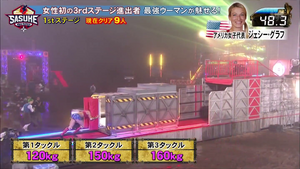
Jessie Graff attempting modified Tackle in SASUKE 37
For female competitors, the boxes each weigh 70 kg (roughly 154 lbs.), 80 kg (roughly 176 lbs.), and 90 kg (roughly 198 lbs.), respectively. In total, the competitors have to push the weight of 240 kg (roughly 528 lbs.). However, akin to the male competitors' version, these weights were increased in the following tournament to 80 kg (roughly 176 lbs.), 100 kg (roughly 220 lbs.), and 120 kg (roughly 264 lbs.) respectively, making the total weight increased to 300 kg (roughly 660 lbs.). Subsequently, the weights were increased yet again to 120 kg (roughly 264 lbs.), 150 kg (roughly 330 lbs.), and 160 kg (roughly 352 lbs.) respectively, making the total weight increased to 430 kg (roughly 946 lbs.).
Competitors could only be determined to clear the obstacle if they had traversed the entire length of the track, demarcated with a black and yellow line, which means they don't have to push the entire contraption in. The netting in the first box is there to assist them in getting over the boxes and onto the platform of Soritatsu Kabe.
Due to the lenient time limit in SASUKE 33 and SASUKE 34, more competitors cleared Soritatsu Kabe after that, which prompt the producers to imply a stricter time limit from SASUKE 35, making the combination of the obstacles become much harder. In SASUKE 39, the Ni Ren Soritatsu Kabe would return on the course, which made the obstacle even more lethal. In addition, bad weather has increased the difficulty of the obstacle, resulting in some competitors losing grip when pushing the obstacle.
Although this obstacle has a very high clear rate (only one victim), it was proven to be a massive energy drainer for the competitors. As a result, most competitors got tired and eventually timed out at the Soritatsu Kabe or Ni Ren Soritatsu Kabe later in the stage (such as Nagano Makoto, Urushihara Yuuji, Matachi Ryo, Kawaguchi Tomohiro and Morimoto Yūsuke).
In a recent interview, Masato Inui, the current producer of SASUKE, mentioned that the difference between this obstacle and the Tackle Machine is that the length of the run-up became much shorter so competitors won't rush onto the obstacle to prevent injuries similar to Yamamoto Shingo. In addition, the safety padding became much thicker and the tracks are modified compared to the Tackle Machine.
Other Appearances[]
Tackle[]
SASUKE Ninja Warrior Mongolia[]
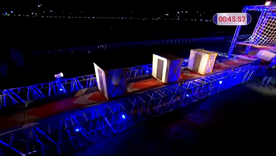
SASUKE Ninja Warrior Mongolia's Tackle
On SASUKE Ninja Warrior Mongolia, the Tackle made its first international appearance outside of SASUKE, appearing as the fifth obstacle in Stage One.
Tackle Machine[]
Ninja Warrior France[]

Ninja Warrior France 8's Tackle Machine
On Ninja Warrior France 8, the Tackle Machine, locally called La Rampe Des Titans (literally The Ramp of the Titans) appeared as the first obstacle in every qualifications. The obstacle was extractly same as first part of the Power Tower in American Ninja Warrior 14, in which competitors must push a box upwards across an inclined track, then they must turn around and run down a declined track, dodging a series of left-right alternating panels that block the track, and finally they must turn around again and run up a ramp as a momentum to perform a long jump to reach the first rope of the Double Rope Swing.
Competitors' Success Rate[]
- All results based on the TBS broadcast and external information found.
SASUKE[]
| Tackle Machine | |||
|---|---|---|---|
| SASUKE | Clears | Attempts | Percentage |
| 5 | 3 | 3 | 100% |
| Total | 3 | 3 | 100% |
| Tackle | |||
|---|---|---|---|
| SASUKE | Clears | Attempts | Percentage |
| 31 | 41 | 42 | 97.62% |
| 32 | 29 | 29 | 100% |
| 33 | 23 | 23 | 100% |
| 34 | 37 | 37 | 100% |
| 35 | 11 | 11 | 100% |
| 36 | 20 | 20 | 100% |
| 37 | 19 | 19 | 100% |
| 38 | 19 | 19 | 100% |
| 39 | 22 | 22 | 100% |
| 40 | 29 | 29 | 100% |
| 41 | 22 | 22 | 100% |
| Total | 270 | 271 | 99.63% |
